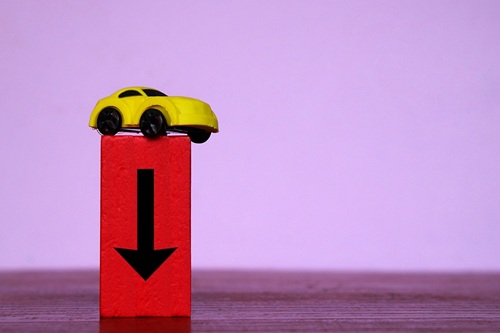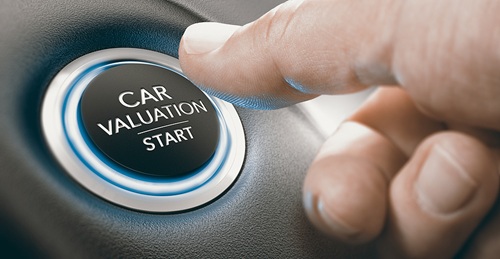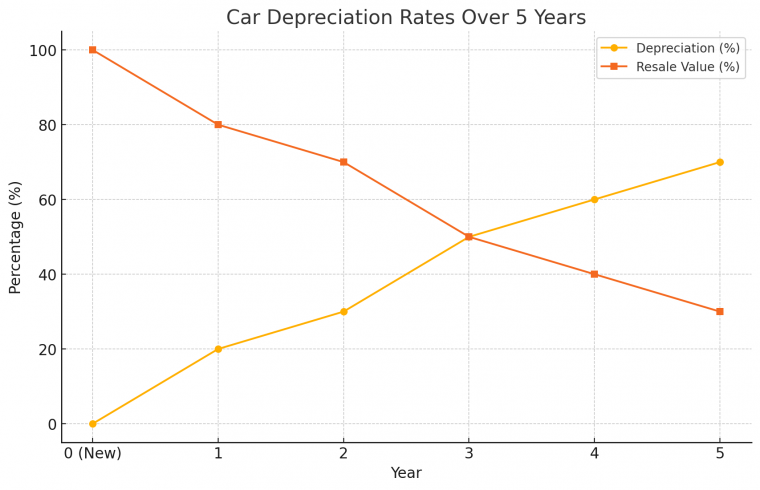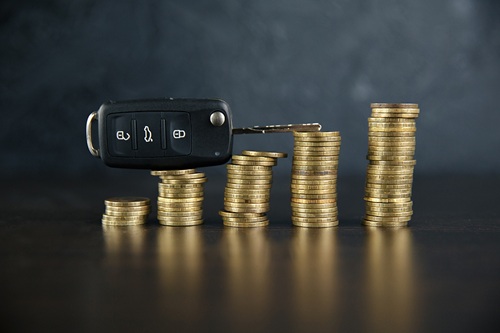Car depreciation starts the moment you drive a new vehicle off the forecourt. While it won’t be worthless immediately, vehicle depreciation rates can significantly impact your car’s resale value over time. Most of us have heard such a dread warning over the years, and while it’s certainly not true, it does contain a nugget of truth.
That truth is that a new car starts to depreciate as soon as it’s wearing number plates and racking up kilometres. It’s also true that, in almost all cases, depreciation is the single biggest cost when it comes to car ownership. But just how much will it cost you? And who decides what a car is worth after three years, or more?

Almost everything you buy depreciates in value, except perhaps — hopefully — your house (although of course maintaining or increasing the value of your house assumes a level of care and repair, the investment of which is sort of a form of depreciation) and your car is a primary example. As is so often quoted, your car is the second most expensive thing you will ever buy, after your house, and so the high costs of depreciation is laid bare. Would you have bought your house if you knew that after three years it would be worth 50 per cent of what you’d paid for it?
Depreciation works on a curve, and the figures presented for each car will be an average. Generally speaking, the biggest drop in value does indeed occur in that first year, not quite as you drive off the forecourt, but close enough. After that, the percentage of the car’s value lost each year starts to flatten out somewhat.
Car Depreciation Rates: How Fast Does Your Vehicle Lose Value?
As a ready-reckoner depreciation calculator, most mainstream models will lose between 50 per cent and 60 per cent of their original purchase value after three years, assuming average annual mileage of 15-16,000km A small handful of cars will have better or worse performance, but these are outliers. A specific and tiny number of cars will actually start to appreciate once they’re sold, but those are usually limited to incredibly small-production-run models of blue-chip desirable brands and models. We’re talking about Ferraris and Porsches, here — your new Hyundai isn’t in this group.

However, you can insulate yourself from depreciation to an extent by doing your research. In one sense, a quick glance at the top-ten selling list of new cars will give you an indication of which cars are craved by new buyers, and presumably buying one of those will give you a better chance of cheating the depreciation curve in three years’ time.
It doesn’t always quite work like that, however. New car buyers and used car buyers are two different species, really. They look for different things, and the downside to buying a popular new model is that in three years’ time there are lots of those around on the second hand market, which can actually have a depressing effect on values.
It’s better to try and find a balance between cars which are popular new, and cars which are popular with used buyers, so get busy checking out second hand and classified websites, and see what’s popular there. Obviously, that means taking something of a gamble that in three years’ time, car buyers’ tastes will have remained the same, but at least you’ll be in the right ballpark. For instance, while the Hyundai Tucson has been the most popular new car in Ireland for the past several years, it’s still slightly behind the venerable VW Golf when it comes to used car searches.
You’re usually going to be on safe ground buying a medium-sized hatchback, saloon, or SUV with a frugal and tax-efficient engine option. That’s what most people will want when it comes to second hand buying, so anything which fits that description will be a fairly safe bet.

What about premium brands?
The rules are basically the same, although when it comes to premium badge cars, you need to be wary of equipment levels — an automatic gearbox is almost a must in the premium car segment these days, as is leather trim (although most premium models have been fitted with leather or man-made leather seats as standard for some time now). Equipment levels on more affordable models are of less significance, although having things such as air conditioning, heated seats, Bluetooth connectivity, and smartphone mirroring is always helpful.

Colour can make a difference, although this is a little tricker to be certain of. The glut of cars on our roads with grey or silver paint in the past decade has come about both because people perceive these as ‘safe-bet’ colours, and also because they’re so prevalent in the brochures of the expensive German brands, so people assume that they’re classy and will play well with subsequent buyers. That’s true, up to a point, and it’s also true that selling a bright yellow or orange car will be harder down the line, so if you fancy a jazzy colour, consider buying a ‘boring’ grey or silver car and then getting it covered with a high-quality vinyl wrap yourself.
Electric Vehicles
Electric cars are something of a special case at the moment. Across the board, EV second hand values have been hit by the reluctance of used car buyers to ‘buy in’ to the technology. That does mean that well-kept, low-mileage electric cars are something of a bargain purchase right now, but while we’ve likely bottomed-out in terms of EV depreciation, it’s also true that electric models will likely continue to suffer sharper depreciation in the next couple of years, compared to hybrids or conventional internal combustion engined cars. That maths will probably reverse between now and 2030, as taxes on petrol and diesel continue to rise, and confidence in the electric cars charging network continues to grow.
How to Minimize Car Depreciation and Maximize Resale Value
Buying a new car on a PCP (Personal Contract Purchase) plan can help to insulate you, up to a point, from depreciation. In a PCP deal, the final payment of the contract is covered by the car’s Guaranteed Minimum Future Value, or GMFV. This value is stated at the beginning of the finance contract, and it is, as the name suggests, guaranteed by the finance company or the car manufacturer. So you know going in exactly what your car will be worth, as a minimum, in three or four years’ time. However, there are two important things to remember. One; car makers set the GMFV deliberately slightly low, so that in theory, when the time comes to trade in, your car is actually worth slightly more than the stated GMFV. That ‘equity’ in the deal then becomes your deposit for the next purchase. However, this isn’t an exact science — as many electric car owners are currently finding out to their cost, GMFVs don’t guarantee the equity, so you may not have as much extra to play with for a deposit come trade-in, if indeed you have any at all.
Secondly, while you know what the value of your car will be, which is a good thing, it doesn’t mean that you’re not paying for that depreciation. Your monthly repayments will have been carefully calculated by the finance provider so that the cost of that depreciation forms part of the repayments.
There’s one final wrinkle to depreciation, and it’s a specifically Irish one. In other markets, such as the UK, there are official guides to the predicted deprecation and second hand value of all cars on sale in the market. These guides are freely available to the public and so you can forewarn yourself of the predicted value of any car you’re thinking of purchasing. In Ireland, things are far more opaque, and the setting of second hand values rather more secretive, so you’ll have to do more legwork and research yourself, and essentially be your own depreciation calculator before committing.
Car Depreciation by Type: Which Vehicles Hold Their Value Best?

When it comes to which cars depreciate the fastest, it’s actually the big expensive stuff that fares worst. While rarefied Ferraris and so forth might avoid the worst, big saloons and SUVs from BMW, Audi, and Mercedes will often suffer 60 per cent or worse losses in the first three years. This can make cars such as the BMW 7 Series or Mercedes-Benz S-Class tempting purchases given that they’ll be so much cheaper than they were when new, but just remember that while the purchase price has come down, the cost of running them hasn’t.
The lowest depreciating cars are generally the smaller, cheaper to run models. Anyone who’s bought a VW Polo, a Mini hatchback, or a Toyota Yaris — for instance — can probably relax in the knowledge that they’re facing depreciation as low as 35-40 per cent in the first three years.
In terms of avoiding the worst ravages of deprecation once you’ve made your choice, there are two golden rules. The first is never modify your car beyond standard. Extra bodykit, tuned engines, or cabin ‘enhancements’ will always put used buyers off.
The most important of all, though, is keeping a good service record. Previous research by Motorcheck has shown that a full set of on-schedule service stamps, preferably from a main dealer, can add as much as €1,500 to the value of a used car.
If you're looking to buy a new car and aren't sure of it's value, use our car history check to avoid any nasty surprises!